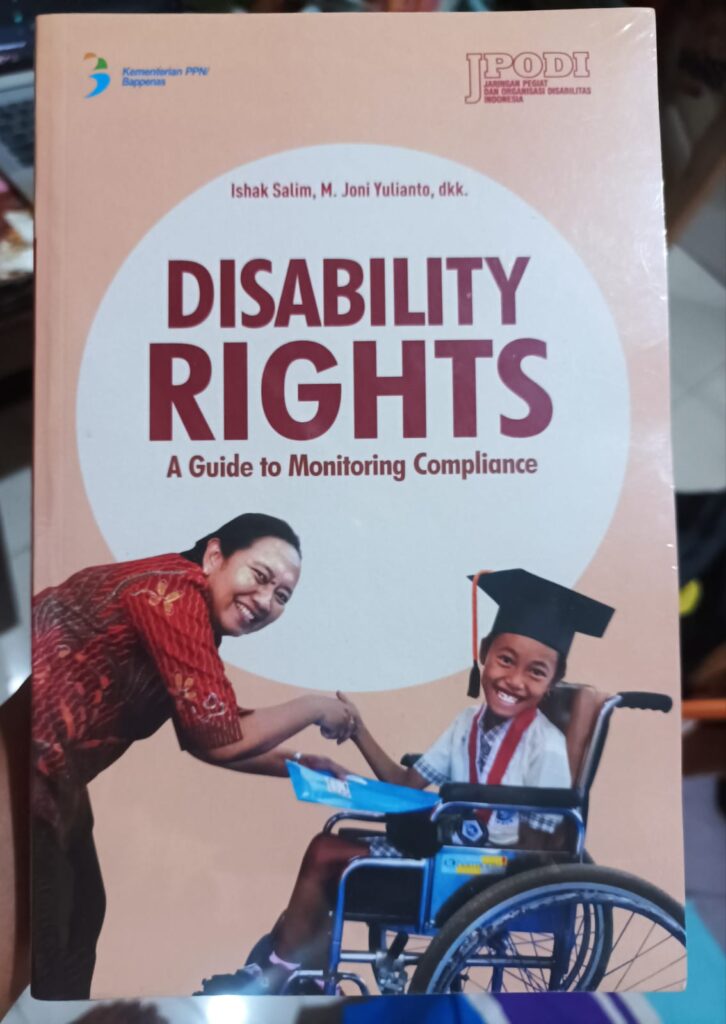English – Indonesia
Cowriter: Ishak Salim and Muhammad Joni Yulianto
Contributors: Disability Activist and DPO Network
This book is divided into six main sections, in which each section contributes to the concept of monitoring the rights of persons with disabilities in the context and situation of Indonesia.
The first section (introduction) highlights the background of why it is urgent to have indicators for monitoring the rights of persons with disabilities.
Opened by preface and introductory words from BAPPENAS, KSP, AIPJ2 and co-writers, this part highlight the shift of disability paradigm to human rights approach that requires change in policy and practice as well as the way to monitor. This section also describes the chronological order of the development of the disability rights indicators document, the purpose, as well as its target.
The second section is situation analysis of persons with disabilities in Indonesia.
This section presents the current contextual situation of persons with disabilities in Indonesia that is described in 10 different issues and sectors. First, we highlight the progression of regulations and policies to guaranty the rights of persons with disabilities, since the issuance of the disability law no.8 of 2016, as well as the implementing regulations. Next, we also highlight the relevance of CRPD, SDGs, and the disability masterplan. As reference for policy and programming direction, the three must be monitored within the consistent monitoring method to be able to track changes and consistently follow the progressive realizations of the rights of persons with disabilities. The next in this section is description of disability situation in different issues such as disability data and social protection, employment, political rights and participation, women with disabilities, as well as village development and inclusion. In addition, short analysis on the impact of COVID-19 and how policies have been adapted to address the situation is also highlighted.
The third section offers definition, conceptual framework and the detail of the disability rights indicators.
While all human rights apply to persons with disabilities, it is important to highlight however that in the context of disability, those rights can only be enjoyed when supported by enabling environment such as accessibility and reasonable accommodation. This is the bases from which the human rights indicators by OHCHR are translated into disability human rights indicators.
Three sets of indicators are introduced in each article of right based on CRPD article. Structure indicator is used to measure how consistent is the existing structure of regulation to the specific norm of right in the convention. Process indicator is used to measure efforts taken by state in making sure that each right is fulfilled protected, respected and promoted. Lastly, outcome indicator is used to measure how each right, qualitatively and quantitatively, has been enjoyed by persons with disabilities.
The fourth section consists of the complete disability rights indicators and monitoring instrument.
This is the majority and main part of this book where the complete indicators and monitoring questions for each indicator are introduced. The structure, process and outcome indicators are developed in each of the 32 CRPD articles. Then, for each indicator, monitoring questions were developed to help finding data for monitoring. In total there are 758 questions that represent 32 CRPD articles of rights.
Knowing how difficult to understand the concept of disability rights indicators and how to apply in the real work of monitoring, this book is equipped with ten illustration and simulation on how indicators are applied to monitor certain rights by certain institution. The 10 sectors described in the simulation are monitoring the rights of women with disabilities (article 6); accessibility (article 9); Situation of risk and humanitarian emergency situation (Article 11); Access to justice for persons with disabilities (Article 13); Personal mobility (Article 20); Right to education (article 24); Right to health services (Article 25); Right to employment (Article 27); Standard of living and social protection (Article 28) and Monitoring Disability Data and Availability of National Data on Disability (Article 31).
Section five provide a practical guide on steps to conduct the disability rights monitoring.
This section is designed to help organizations of persons with disabilities, civil societies organizations, human rights and government institutions to plan, design and implement the disability rights monitoring using this instrument. Five key steps are explained in this section that includes defining scope of monitoring, developing monitoring team, adaptation of indicators and monitoring questions based on scope of monitoring, data collection, analysis, and reporting and dissemination.
In addition, in the final section we provide supplement of references to help readers better understand the concept of disability rights and paradigm.
This supplementary of knowledge will help readers and users of the disability rights indicators to learn the basic concept and foundational understanding of disability, which will help to better understand the problem and situation of persons with disabilities, and help to gain better technicalization of possible solution to look at in minimizing vulnerability of persons with disabilities. With this complementary reading, we hope that readers and users of this book will get the message of the human rights model of disability instead of individual approach.
In this section, the complementary knowledge includes disability language and definition, concept of disability rights based on the convention, general comments on CRPD articles, as well as the concept of medical, social, and human rights model of disability.
More information of this book contact:
joni.yulianto@gmail.com; isangkilang@gmail.com
Happy reading.


Komentar Terbaru